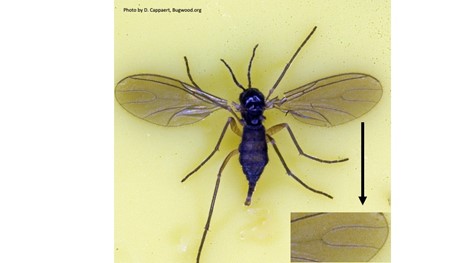Nothing is more welcoming in the office, waiting room, or conference room than lush greenery. The benefits of plants in the workplace are well documented. They remove pollutants, help workers relax and refocus, increase productivity, and make the office look better.
So why aren’t they everywhere?
Maybe it’s because of those irritating little hitchhikers, those gnats that hover around potted plants and in the window. It is easy to imagine them flying into your eyes and nose. Could they be eyeballing your lunch?
Those are fungus gnats (Bradysia spp.) and fortunately they have no interest in your body orifices or your food. The adult gnats are small (1/8 inch or less), dark, and delicate (Fig. 1) . They have a distinct “Y-shaped” wing vein pattern on their light gray to clear wings (Fig. 2). With their long legs and antennae, they resemble mosquitos, but they don’t bite people.
The larvae of fungus gnats live in the top one to two inches of indoor plant potting media and feed on fungi, algae and organic matter (Fig. 3). Sometimes they feed on plant roots and leaves that are found in the potting media. The larvae transform into adult flying gnats who go on to lay eggs in the moist potting media to begin the cycle again.
The life cycle may be completed in a few weeks at room temperatures and there may be multiple, overlapping generations a year. The larvae can cause plant stunting, particularly in young plants and seedlings. Often plant damage goes unnoticed and the flying adults are identified as the nuisance pest.
Managing fungus gnats
The solution is simple. Don’t overwater indoor plants. Fungus gnats need high moisture levels in the potting soil. Letting the soil go dry between watering often solves the problem. The egg-laying female is less attracted to dry potting media, and the survivability of larva that hatch from the eggs is decreased.
Trapping the adults with a yellow sticky card (sold as Gnat Stixã) will also help to reduce the number of larvae in the next generation. Simply place the yellow sticky card underneath the plant canopy or on the edge of the container. If changing water management and trapping adults does not eliminate the problem, chemical control may be warranted. Insecticide control of the adult gnat is not effective. A soil drench with an appropriately labeled liquid insecticide will kill the larva. Always read and follow the direction on the insecticide label.
Enjoy your office plants!
When posting on social media, please use the hashtag #PlantsDoThat. Please feel free to share or adapt this article in your newsletter or other customer communications.
The National Initiative for Consumer Horticulture (NICH) is a consortium of industry leaders who are promoting the benefits and value of horticulture. NICH brings together academia, government, industry, and nonprofits to cultivate the growth and development of a healthy world through landscapes, gardens and plants — indoors and out.

Figure 1. Fungal gnat adult. 
Figure 2. Fungal gnat Y-shaped” wing vein pattern.
Figure 3. Fungal gnat larvae eat fungi, other organic material in the soil and plant roots.

Leave a Reply